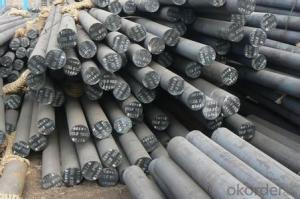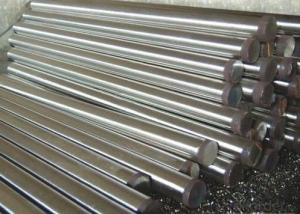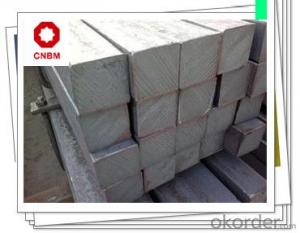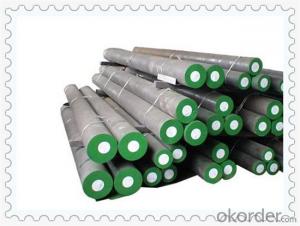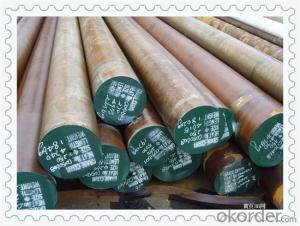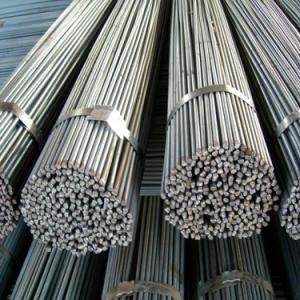Roung BAR
- Loading Port:
- China Main Port
- Payment Terms:
- TT OR LC
- Min Order Qty:
- -
- Supply Capability:
- -
OKorder Service Pledge
OKorder Financial Service
You Might Also Like
Product Description:
Specifications of High Quality Round Bar
1. Grade: GB, JIS, ASTM, EN
2. Grade: Q235, SS400, A36, S235JR
3. Diameter and mass: As below
Diameter | Mass | Diameter | Mass | Diameter | Mass |
(mm) | (kg/m) | (mm) | (kg/m) | (mm) | (kg/m) |
6 | 0.22 | 22 | 2.98 | 53 | 17.30 |
7 | 0.30 | 24 | 3.55 | 56 | 19.30 |
8 | 0.40 | 25 | 3.85 | 60 | 22.20 |
9 | 0.50 | 26 | 4.17 | 63 | 24.50 |
10 | 0.62 | 28 | 4.83 | 65 | 26.00 |
11 | 0.75 | 30 | 5.55 | 70 | 30.20 |
12 | 0.89 | 32 | 6.31 | 75 | 34.70 |
13 | 1.04 | 34 | 7.13 | 80 | 39.50 |
14 | 1.21 | 36 | 7.99 | 85 | 44.50 |
15 | 1.39 | 38 | 8.90 | 90 | 49.90 |
16 | 1.58 | 40 | 9.86 | 95 | 55.60 |
17 | 1.78 | 42 | 10.90 | 100 | 61.70 |
18 | 2.00 | 45 | 12.50 | 120 | 88.85 |
19 | 2.23 | 48 | 14.20 | 140 | 120.93 |
20 | 2.47 | 50 | 15.40 | 150 | 138.82 |
4. Material: Mild Steel
5. Heat treatment of high quality steel:
Fire: Isothermal annealing temperature is 800 ~ 880 °C, with 10 ~ 20 °C, the furnace cooling to about 600 °C, hardness above HB269.
Preheat temperature: 730-730 °C
Quenching temperature: 1190-1210 °C
Tempering temperature: 540-595 °C
Cold drawn, hardness 285 HBS
Cold drawn after annealing condition, hardness 277 HBS
Quenching methods: oil quenching, air cooling or salt bath quenching
Usage and Applications of High Quality Round Bar
1) Suitable for making various strong cutting tool abrasion resistance, impact resistance.
2) Used to produce all kinds of high hard and super hard saw blade, drill, tap, broach, gear hob and various kinds of milling cutter.
3) Used for advanced punching die, screw die, and the toughness and complicated shape of the punch, etc.
4) Is used for cold forging die and drawing mode, etc.
5) Recommended watchcase factory, screw factory and other cold stamping products industry use.
Packaging & Delivery of High Quality Round Bar
Packaging Detail: All goods are packed in bundle with steel strips and shipped by break bulk vessel or container (depend on target market and different ports)
Delivery Detail: 45 days
Trade terms: FOB, CFR, CIF
MOQ: 25 tons per specification; we can negotiate the quantity if the specification is normal or we have stock of one specification.
Weight: Theprice invoicing on theoretical weight basis or actual weight basis depends on customer’s request.
Shipment: The shipment of bulk break or container is depends on customer’s request and the situation of the port of destination.
Documents given: Full set of original clean on board bill of lading; Original signed commercial invoice; Original packing list; Policy of insurance; Certificate of origin and what the target market needs.
Production Flow of High Quality Round Bar
The common processes are preheated forging quenching, dual refinement solution process, cooling quenching and isothermal quenching. We use heat treatment for dual refinement solution process. The main measures process is high temperature solution and refinement cycle. High temperature solution can improve the carbide morphology and particle size. The aim is to make the loop refinement ultrafine austenite grains.
- Q: What is the maximum carbon content allowed for steel round bars?
- The maximum carbon content allowed for steel round bars typically ranges from 0.25% to 0.30%.
- Q: Can steel round bars be used for making transmission components?
- Yes, steel round bars can be used for making transmission components. Steel is commonly used in the manufacturing of transmission components due to its high strength, durability, and resistance to wear and tear. The round bars can be machined and shaped into various transmission components such as gears, shafts, and couplings, providing reliable and efficient performance in transmission systems.
- Q: How are steel round bars stored?
- To ensure the safety and easy accessibility of steel round bars, they are typically stored in a manner that prioritizes these factors. One common storage method involves horizontally stacking the bars on a pallet or rack system, often bundling them together and securing them with straps or wire to prevent rolling or shifting. Another option is to store the bars vertically in racks, placing each bar in a designated slot to avoid contact or damage. In both cases, maintaining proper spacing between the bars is crucial to allow for sufficient air circulation and prevent potential corrosion. Additionally, it is essential to store steel round bars in a dry and covered area to shield them from moisture, dust, and other environmental elements. Proper labeling and inventory management systems are also of utmost importance to ensure easy identification and retrieval of the bars when necessary.
- Q: Are steel round bars suitable for the production of axles?
- Indeed, axles can be produced using steel round bars. Steel, being a robust and long-lasting material, offers exceptional strength and stability, rendering it an optimal selection for axles. The circular form of these bars facilitates effortless machining and shaping processes, guaranteeing an accurate and efficient axle design. Moreover, steel round bars possess commendable resistance against wear, fatigue, and impact, indispensable attributes for axles that must endure demanding loads and harsh environments. All in all, steel round bars are a dependable and extensively employed material in diverse industries, including automotive, manufacturing, and construction, for axle production.
- Q: What are the different types of carbon steel round bars?
- There are several different types of carbon steel round bars available on the market. Some of the commonly used types include: 1. Mild Steel Round Bars: These are the most common type of carbon steel round bars. They have a low carbon content and are easy to weld, cut, and form. Mild steel round bars are suitable for general engineering purposes and have excellent machinability. 2. Medium Carbon Steel Round Bars: These round bars have a higher carbon content than mild steel round bars. They offer better strength and hardness, making them suitable for applications that require higher load-bearing capacity. Medium carbon steel round bars are commonly used in automotive, construction, and machinery industries. 3. High Carbon Steel Round Bars: These round bars have a higher carbon content, typically above 0.60%. They offer superior strength, hardness, and wear resistance. High carbon steel round bars are commonly used in applications that require high strength, such as springs, cutting tools, and axles. 4. Free Cutting Steel Round Bars: These round bars have added elements, such as sulfur or lead, to improve machinability. They are commonly used in applications where easy machining is required, such as in the production of bolts, screws, and fittings. 5. Alloy Steel Round Bars: These round bars contain additional alloying elements, such as chromium, nickel, or molybdenum, to enhance specific properties. Alloy steel round bars offer improved strength, hardness, corrosion resistance, and heat resistance. They are commonly used in applications that require high performance, such as in the aerospace, oil and gas, and automotive industries. It is important to consider the specific requirements of your project or application when selecting the type of carbon steel round bar to ensure optimal performance and durability.
- Q: How do steel round bars compare to copper round bars?
- Different applications call for distinct properties in steel and copper round bars. To begin with, steel round bars are known for their remarkable strength and durability. This versatile material can withstand high levels of stress, making it perfect for structural and industrial uses. With its high tensile strength, steel can resist pulling forces without breaking. Construction projects, automotive components, and machinery manufacturing frequently rely on steel round bars. On the other hand, copper round bars possess unique characteristics that set them apart from steel. Copper is an exceptional conductor of heat and electricity, making it indispensable in electrical wiring and plumbing systems. Its high resistance to corrosion makes copper pipes widely used in plumbing applications. Additionally, copper's antimicrobial properties make it a preferred material for medical equipment and food processing industries. When it comes to cost, steel round bars tend to be more affordable than copper round bars. Steel is abundantly available and has lower production costs compared to copper. This cost advantage makes steel a popular choice for budget-conscious applications. In terms of appearance, steel round bars have a sleek, metallic finish, while copper round bars exhibit a distinct reddish-brown appearance. This visual distinction often influences the selection of materials in architectural and decorative applications. In summary, steel round bars and copper round bars possess different properties that suit them for specific purposes. Steel offers exceptional strength and durability, making it suitable for structural and industrial applications. Copper, on the other hand, is valued for its conductivity, corrosion resistance, and antimicrobial properties, making it ideal for electrical, plumbing, and medical applications. The choice between steel and copper depends on the specific requirements of the project and the desired properties of the material.
- Q: Can steel round bars be used for making heat exchangers?
- Steel round bars are suitable for constructing heat exchangers. Steel is widely used in heat exchangers because it has great thermal conductivity, high strength, and corrosion resistance. Steel round bars can be easily machined and molded to match the specific design needs of a heat exchanger. Moreover, steel is easily accessible and cost-efficient, making it a popular option for manufacturing heat exchangers in different industries. However, it is crucial to take into account the particular application and operating conditions of the heat exchanger to ensure that the selected steel grade is compatible and capable of enduring the necessary temperature and pressure.
- Q: Can steel round bars be machined?
- Yes, steel round bars can be machined. Machining processes such as turning, milling, drilling, and grinding can be used to shape and cut steel round bars according to specific requirements.
- Q: Can steel round bars be used for making bearings?
- Making bearings can indeed involve the use of steel round bars. However, it is crucial to acknowledge that the suitability of steel round bars for bearing applications relies heavily on the specific type of steel utilized and the manufacturing process employed. Bearings commonly encounter high loads and necessitate qualities such as good wear resistance, low friction, and high durability. For this reason, steel round bars made from top-notch alloy steels, such as chrome steel or stainless steel, are frequently employed in bearing production due to their exceptional mechanical properties. These steel round bars undergo particular heat treatment procedures, such as quenching and tempering, to enhance their hardness, strength, and wear resistance. Moreover, the round bars are usually machined with precise tolerances to ensure proper fit and alignment within the bearing assembly. To guarantee the most optimal performance, reliability, and longevity of bearings under various operating conditions, it is essential to seek advice from materials and manufacturing experts or consult industry standards. This will ensure the appropriate selection of steel round bar material and manufacturing processes for bearing applications.
- Q: Can steel round bars be used for making sway bars?
- Yes, steel round bars can be used for making sway bars. Sway bars, also known as stabilizer bars or anti-roll bars, are used in vehicles to reduce body roll and improve stability when cornering. Steel round bars are commonly used for this purpose due to their high strength and durability. The round shape allows for even distribution of forces and provides torsional stiffness, which is crucial for sway bars to effectively control body roll. Additionally, steel is readily available, cost-effective, and can be easily fabricated into the desired shape and size for sway bar applications.
Send your message to us
Roung BAR
- Loading Port:
- China Main Port
- Payment Terms:
- TT OR LC
- Min Order Qty:
- -
- Supply Capability:
- -
OKorder Service Pledge
OKorder Financial Service
Similar products
Hot products
Hot Searches
Related keywords
